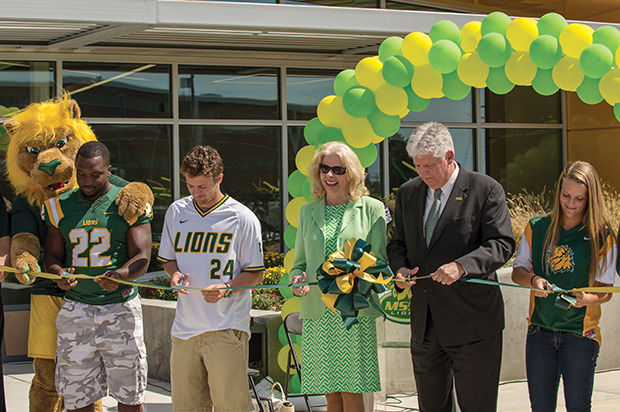Southern trends in right direction
On Sept. 19, the Missouri Southern campus in Joplin, opened another finished product. The end zone facility houses a number of amenities that benefit a number of sports, represented here by [left to right] senior football player Giresse Forchu, senior baseball player Payton Walker and sophomore Abi Corbett. Also assisting in the ribbon cutting are [left to right] Roary, President and CEO of Freeman Health Systems Paula Baker and University President Alan Marble.
Missouri Southern’s facelift is an ongoing process, obvious from the number of projects reaching completion around the campus, but at the ribbon cutting for the finished end zone facility Saturday Sept. 19, the University took another step toward the ultimate goal.
At the ceremony, Athletic Director Jared Bruggeman spoke at length about the project. He outlined the details of the original committee tasked with the planning of a number of improvements, one of which was the north end zone facility.
“The committee was to evaluate Fred G. Hughes Stadium and determine what, if any, renovations and additions may be needed,” said Bruggeman. “The criteria that was reviewed included student-athlete welfare, coaching and teaching environment, fan accommodations, private sponsorship and finally, event administration and facility management.”
Members of the committee included Bob Harrington, Terri Agee, Rod Anderson, Sallie Beard, David Haffner, William Huffman, Virginia Lass, Michael LaFerla, Miron Mckiney and Jim Zerkel.
“The stadium strategic plan committee concluded that the stadium was insufficient in all of these areas,” said Bruggeman, “and that three construction options would rectify the situation. The suggestions included a north end zone facility, complete renovations of the west home stands and a minimal investment on the east, or visiting stands. This report was ultimately presented to the Board of Governors on Jan. 20, 2006.”
A number of issues arose during the process at this point, most notably but not limited to the tornado that devastated the community in 2011. The University faced additional limitations from the struggling economy, changes in leadership, MIAA fluctuation and NCAA regulations.
Ultimately, the main focus for completion remained the same: to benefit the student-athletes on campus. This motivation drove the committee originally and continued to propel efforts to completion.
“This state-of-the-art building represents a terrific asset to our student-athletes, our fans and supporters of Missouri Southern,” said University President Alan Marble. “This new facility helps ensure not only our competitiveness in the MIAA, but the entire NCAA Division II.”
Since 2009 the University has seen a number of improvements as part of the plan prior to Southern’s 100th anniversary. In 2009 the George S. Bemdiek Recreation Center was completed; in 2010 the school unveiled the 85,000-square-foot Julio León Health Sciences Center, and earlier this year athletics took the first step with the realization of Warren Turner Field, a baseball complex on campus.
The latest in the long line of improvements was due to a number of supporters. For the end zone facility, the name of the main supporter adorns the structure.
“As we officially open this beautiful new end zone facility, we want you to know that Freeman proudly supports and serves Missouri Southern University,” said President and CEO of Freeman Health Systems Paula Baker. “We look forward to this continued partnership and the opportunity to create a strong health care presence to benefit MSSU, its students, its alumni and the Four State area.”
The fruition of these improvements will be evident for years to come, and as student-athletes continue to acclimate themselves to their new surroundings, those who have made it possible relish in the possibilities to come.
“We have been very diligently working on completing the committees vision, and this is obviously a large step in that direction,” said Bruggeman. “It is designed to allow the athletes to become the best on the field, in the classroom and in their mind … [W]e have shown the student-athletes and their families that we are dedicated to their health and their well-being and ultimately to assisting in making them productive members of society. No doubt, this is a game-changer for MSSU and the athletics department.”
Your donation will support the student journalists of Missouri Southern State University. Your contribution will allow us to purchase equipment and cover our annual website hosting costs.




























